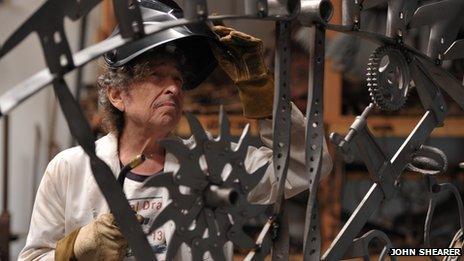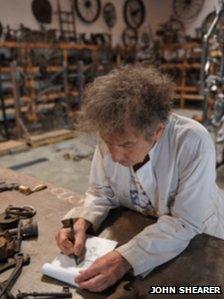Bob Dylan unveils first metal-work sculpture exhibition
- Published

Bob Dylan at his iron works studio, September 2013
More than 50 years since recording his first record, Bob Dylan has put his sculptures on display for the first time. Until now, just a handful of celebrities seem to have known they existed. But a London gallery is inviting the public to view them for free in an exhibition entitled Mood Swings.
Most people know Bob Dylan as a singer and a songwriter. Some will also be aware that he is a prolific visual artist and has been exhibiting paintings for nearly two decades.
However, even seasoned Dylan-watchers have been taken by surprise with news that, at the age of 72, he is unveiling a number of large scale metal sculptures.
Accompanying publicity photographs show him using professional welding tools and wearing a protective visor.
Most of the new exhibits are gates.
"Gates appeal to me because of the negative space they allow," says Dylan in the gallery brochure. "They can shut you out or shut you in. And in some ways there is no difference."
Spanners and axes
The gates are made of scrap metal items including spanners, chains, car parts and axes. Some also have musical motifs, such as a treble clef or a guitar.

Bob Dylan's studio is in Los Angeles
Each contains a small metal buffalo, marked with the sign Black Buffalo Iron Works, followed by Dylan's signature.
Paul Green, the president of the Halcyon Gallery in London - which is showing the works, says Dylan draws inspiration from memories of iron ore mines from his youth in Hibbing, Minnesota.
"He's drawing from an industrial past, a working man's past," says Mr Green. "It's partly about looking back but it's also about resurrecting these items and the physical act of putting these objects together."
Mr Green says that when he visited Dylan in his studio in Los Angeles, there was a huge store of used metal.
"Dylan designs the works and decides which objects will be used. He does some welding himself and has one or two people to help him but he is intimately involved in the whole process."
Hardcore Dylan fans may even have recognised subtle references to his metalwork hobby in the past.
As long ago as 1978, Dylan told the Minnesota Times that when he returns to his home state:"I like to blast sculpture out of metal". Although he also said - somewhat implausibly - that he likes to roller-skate, ice-skate and fish.
There are some intriguing parallels between the sculpture show and some of Bob Dylan's songs.
Gates of Eden from 1965 is a surreal ballad which draws on imagery from the Bible's Book of Genesis.
And in the 1974 song Never Say Goodbye Dylan sang:
"My dreams are made of iron and steel
"With a big bouquet
"Of roses hanging down
"From the heavens to the ground."
'Sense of fun'
Chris Topp, who makes ornamental gates for a living, travelled from North Yorkshire to see the show. He was impressed by Dylan's sense of fun.
"I was expecting to be disappointed, thinking Dylan would be well out of his depth, but it's good," asserts Mr Topp.
"What a wonderful thought that this man, who some people think of as a god, is actually interested in scrap yards, just like the rest of us."
Studying the pieces closely, Mr Topp noted that "the welds are visible. That's not to be encouraged but he's got away with it.
"I would like to teach him forge work because then he could start creating objects instead of just using found ones."

Dylan's studio is full of reclaimed scrap metal parts ready to be made into sculptures
In addition to the eight gates, there are also tables and works which Dylan has entitled Gangster Doors.
These are the battered doors of American cars from the 1920s, some of which have bullet holes in them. Each is accompanied by a poster of a notorious gangster, such as Al Capone.
Alongside the sculptures, two dimensional works in the exhibition include previously unseen pieces from Dylan's celebrated Drawn Blank series of paintings and drawings.
There is also an enormous, vividly coloured oil painting called Train Tracks, painted in 2013.
Next to it are examples of a project called Side Tracks; 327 slightly different variations on a picture of train tracks, each marked with the location of a Bob Dylan concert venue.
The Halcyon Gallery's Paul Green says Dylan chose to premiere the exhibition in London because he has built a relationship of trust with the curators.
It was also important to the artist that the works could be seen by the public and admission to the exhibition is free.
However, the items are for sale, with prices upon request. They start at £35,000.
- Published13 November 2013
- Published24 September 2013
- Published24 August 2013